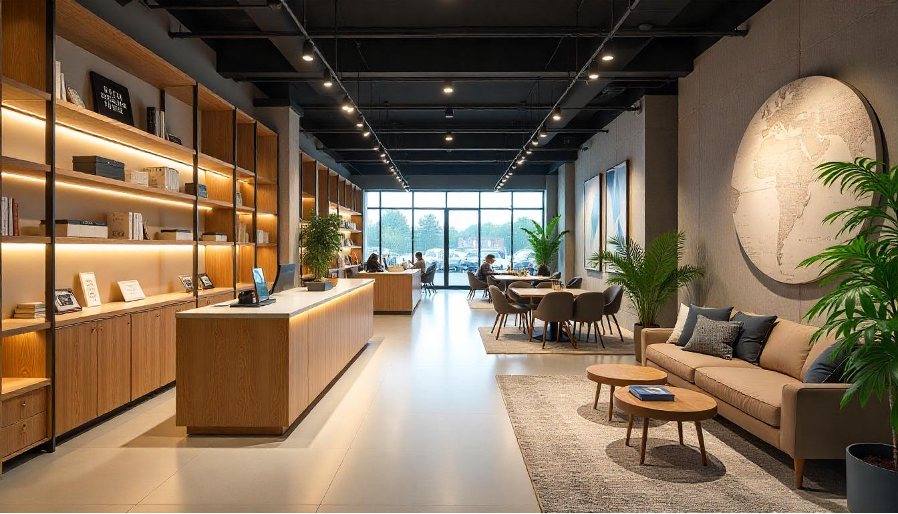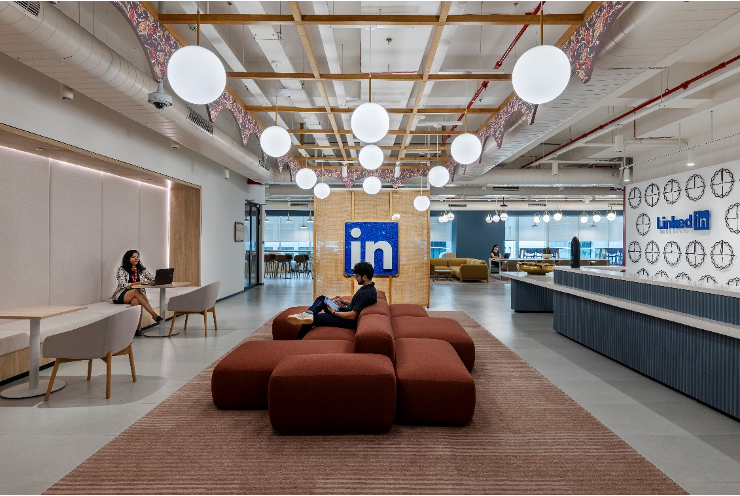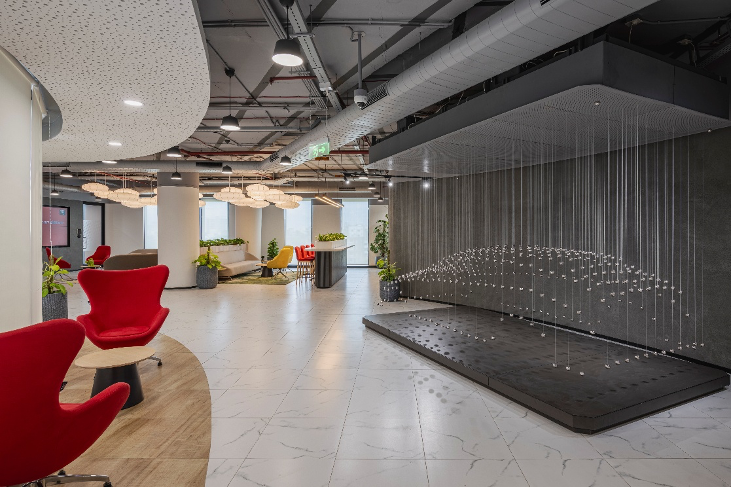As workplace design evolves, industries like retail, gaming, and hospitality offer valuable insights for creating human-centered office environments that prioritize employee experience, adaptability, and innovation. Zyeta’s Sudarshan Uppunda shares how we can apply these lessons to the future of work.
Workplace design stands at a pivotal juncture. The contemporary office transcends its traditional function as a mere container for desks and computers; it is increasingly recognized as a dynamic ecosystem influencing productivity, organizational culture, and talent attraction. For too long, workplace design has arguably operated within a self-referential paradigm. To genuinely evolve and meet the demands of a rapidly changing future, the industry must look beyond familiar approaches and draw inspiration from unexpected domains. The imperative lies in disrupting traditional models and embracing a more holistic, human-centric methodology. Therefore, workplace design must actively seek insights from other industries that have demonstrated mastery in customer experience, adaptability, and innovation.

Why Workplace Design Benefits from External Perspectives
The post-pandemic era has significantly accelerated the need to reconsider office environments as compelling destinations. These spaces must attract employees by offering more than just work points; they must inspire, foster well-being, and enable seamless collaboration.
Industries such as retail, mixed-use development, visual effects (VFX), entertainment, gaming, and hospitality have navigated comparable challenges in engaging increasingly discerning consumers amidst digital disruption.
These sectors have adapted with remarkable agility, consistently investing in emotionally resonant experiences, cutting-edge technology, and spatial strategies that prioritize human behavior. The lessons from their evolution offer invaluable perspectives for reimagining workplaces that are not only high-performing but also profoundly human-centered. Specifically, the retail sector has undergone a significant transformation from purely transactional spaces to immersive, experiential environments. This evolution provides a robust blueprint for workplaces seeking to enhance employee experience and cultivate meaningful places of work.
𝗪𝗵𝗮𝘁 𝗰𝗮𝗻 𝘄𝗼𝗿𝗸𝗽𝗹𝗮𝗰𝗲𝘀 𝗹𝗲𝗮𝗿𝗻 𝗳𝗿𝗼𝗺 𝘁𝗵𝗲 𝘄𝗼𝗿𝗹𝗱 𝗼𝗳 🎮 𝗴𝗮𝗺𝗶𝗻𝗴 𝗮𝗻𝗱 🎬 𝗲𝗻𝘁𝗲𝗿𝘁𝗮𝗶𝗻𝗺𝗲𝗻𝘁?
Retail’s Strategic Approach to Spatial Influence
The core principle underpinning retail’s success lies in its sophisticated understanding and influence of behavior within a physical space. The methodology for achieving this has become increasingly refined. Today, retail leverages data analytics, behavioral science, and advanced technology to create hyper-personalized and responsive environments. This customer-centric mindset, driven by measurable outcomes, is precisely the perspective that the next generation of workplace design needs to integrate.
By viewing employees as internal “customers”, workplace strategists and designers can adapt these advanced retail strategies to cultivate more engaging, productive, and satisfying work environments. The following sections outline how to move beyond superficial inspiration and tap into the deeper veins of retail innovation.

Five Key Touch Points and Actionable Strategies from the Retail Industry:
1. The Power of First Impressions and Wayfinding
The retail industry consistently invests in aesthetically compelling storefronts, intuitive layouts, and clear signage, all informed by established design principles and a deep understanding of consumer psychology. While data can inform traffic flow, the initial emotional impact is frequently driven by visual appeal and brand storytelling.
Implementation in Workplace Design: Reception areas should be designed to embody company culture and values, creating an immediate connection. Implement intuitive wayfinding systems utilizing consistent signage, color-coding, and potentially digital directories. Ensure clear sightlines and logical flow throughout the space.
Implementation in Workplace Strategy: Develop a seamless and welcoming visitor management process. Provide pre-arrival information and digital tools for efficient navigation. Consider the experience of new hires during their initial days, ensuring a comprehensive orientation and clear access to resources.
2. Behavioral Nudges and Choice Architecture
Retail design strategically employs behavioral nudges – subtle cues that influence customer behavior without overtly restricting choices. Examples include the strategic placement of healthy snacks near checkout counters or the use of floor markings to guide traffic flow.
Implementation in Workplace Design: Strategically position collaboration zones in visually prominent and easily accessible areas to encourage spontaneous interaction. Locate wellness rooms or quiet pods in discoverable yet unobtrusive locations. Utilize visual cues, such as distinct signage, floor markings, or artwork, to promote stair usage, highlight sustainable practices, or direct employees to specific resources.
Implementation in Workplace Strategy: Identify desired workplace behaviors. Design interventions using subtle cues embedded within the physical environment. Clearly communicate the intent behind these nudges to foster understanding and adoption among employees.
3. A/B Testing and Continuous Optimization
Successful retailers consistently employ A/B testing for different layouts, merchandising strategies, and digital interfaces to measure their impact on key metrics like engagement and sales. This approach facilitates continuous improvement based on real-world data.
Implementation in Workplace Design: Flexible design and modular spaces that can be easily adapted for testing various layouts, furniture arrangements, or technology integrations. Establish mechanisms for gathering employee feedback on pilot projects to inform subsequent design iterations.
Implementation in Workplace Strategy: Define clear metrics for evaluating the success of workplace design interventions, such as space utilization rates, employee satisfaction, and collaboration frequency. Collect both qualitative and quantitative data and analyze the results to inform future design decisions and optimize the workplace over time.
4. Visual Merchandising and Storytelling
The retail industry leverages visual displays, product arrangements, and storytelling elements to capture attention, communicate brand narratives, and forge emotional connections with customers.

Implementation in Workplace Design: Integrate brand elements through environmental graphics, consistent color palettes, and strategically placed artifacts. Utilize digital displays to showcase company milestones, employee stories, and real-time operational data.
Implementation in Workplace Strategy: Develop a clear internal communication strategy that leverages the physical environment to reinforce key messages and organizational values. Curate displays that celebrate team achievements and promote a collective sense of shared identity.
5. Data-Driven Journey Mapping and Predictive Analytics
Modern retailers meticulously track customer movement, dwell times, and purchase patterns. This detailed analysis allows them to optimize store layouts, product placement, and staffing levels based on real-time insights and predictive analytics.
Implementation in Workplace Design: Strategically place sensors (e.g., occupancy, environmental) to gather data on space utilization and environmental conditions. Design layouts that facilitate the easy collection and analysis of movement patterns. Consider the placement of key amenities and collaboration zones based on anticipated traffic flow.
Implementation in Workplace Strategy: Define key metrics for workplace performance, such as space utilization rates and collaboration frequency. Use these insights to optimize space allocation, identify underutilized areas, and improve the flow of people and information. Predictive analytics can further inform future space needs based on team growth and project forecasts.
In Conclusion
The retail industry’s evolution from purely transactional stores to immersive, customer-centric experiences offers invaluable lessons for contemporary workplace design. By consciously embracing personalization, atmosphere, compelling brand storytelling, inherent flexibility, well-considered amenities, and integrated technology, workplaces can create environments that truly support the evolving future of work. These are spaces that inspire, engage, and empower employees, fostering environments where human intelligence can thrive.


